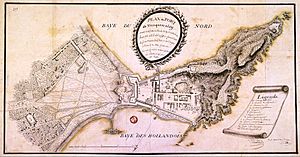Capture of Trincomalee facts for kids
Quick facts for kids Capture of Trincomalee |
|||||||
|---|---|---|---|---|---|---|---|
| Part of the Fourth Anglo-Dutch War | |||||||
 A 1782 French map of Fort Fredrick, made after Suffren recaptured the port |
|||||||
|
|||||||
| Belligerents | |||||||
| Commanders and leaders | |||||||
| Edward Hughes | Iman Willem Falck | ||||||
| Strength | |||||||
| 800 | 450 | ||||||
| Casualties and losses | |||||||
| 21 killed 42 wounded | 13 killed 430+ captured |
||||||
The Capture of Trincomalee happened on January 11, 1782. It was a big battle between Great Britain and the Dutch East India Company during the Fourth Anglo-Dutch War. After taking over Negapatam, an important Dutch base in India, British forces attacked the Dutch port of Trincomalee in Sri Lanka. They successfully captured Fort Fredrick and Fort Ostenburg. This gave them control of the city, its port, and the ships docked there.
Contents
Why the Battle Happened
In 1778, France joined the American War of Independence. Because of this, Great Britain quickly tried to take control of French colonies in India.
War with the Dutch
In December 1780, Britain also declared war on the Dutch Republic. One reason was that the Dutch were selling weapons to the French and American rebels. In early 1781, Iman Willem Falck, the Dutch governor of Trincomalee, heard this news.
British Plans in India
That summer, Lord Macartney arrived in Madras to become its new British governor. He brought news of the new war and gathered British troops. Their goal was to take over Dutch areas in India and Ceylon. These troops first attacked Negapatam, a main Dutch port. They captured it on November 11, 1781.
The Attack on Trincomalee
After their win at Negapatam, British Admiral Edward Hughes prepared for the next attack.
Journey to Trincomalee
- He took 500 volunteer sepoys (Indian soldiers serving the British).
- He also had 30 artillerymen and other European volunteers.
- They sailed towards Trincomalee on January 2, 1782.
- Two days later, their ships anchored in Trincomalee Bay.
Capturing Fort Fredrick
On January 5, the troops landed about 3 miles (5 km) north of Fort Fredrick. They quickly moved towards the fort. That night, a group of marines managed to get inside the fort. They surprised the 43 soldiers guarding it and captured them without a fight. This made it easier to attack Fort Ostenburg, which controlled the harbor.
Attacking Fort Ostenburg
On January 8, the marines captured a hill that overlooked Fort Ostenburg. Admiral Hughes then asked Governor Falck to surrender. Hughes sent his chief engineer, Major Geils, to deliver the message. Since Geils was not blindfolded, he could see that the fort might be taken by a sudden attack.
Two days later, Geils was sent with a second request to surrender, but Governor Falck still refused. So, Admiral Hughes ordered the attack to happen the next morning.
The Final Assault
The main attack force had 450 marines and sailors. They were joined by volunteers and sailors carrying ladders. Early on January 11, a group of marines managed to get through openings in the fort's walls. After a short fight, the Dutch soldiers inside surrendered.
What Happened Next
After the battle, Admiral Hughes placed companies of sepoys and some artillerymen in the two forts. He then took his troops and sailed back to Madras.
French Arrival
When Hughes arrived in Madras on February 8, he learned that a French fleet had come to the area. This fleet was led by Bailli de Suffren. Suffren's goal was to challenge British control of the seas near India. In August 1781, Suffren took advantage of Hughes being away from Trincomalee and recaptured it. Hughes and Suffren then fought another famous battle shortly after, on September 3.
Peace Treaty
Governor Falck was allowed to travel to Batavia (in the Dutch East Indies) to tell his leaders about the Dutch loss. The Dutch got back control of Ceylon and most other places the British had captured (except Negapatam) with the 1784 Treaty of Paris. In return, they promised not to interfere with British trade ships in the Indian Ocean.

